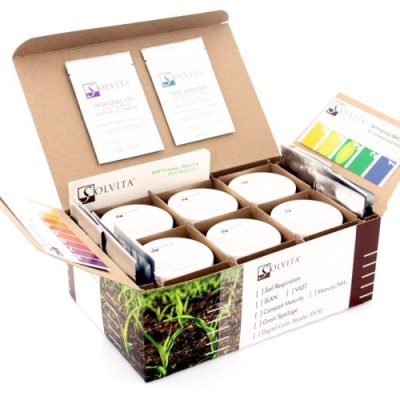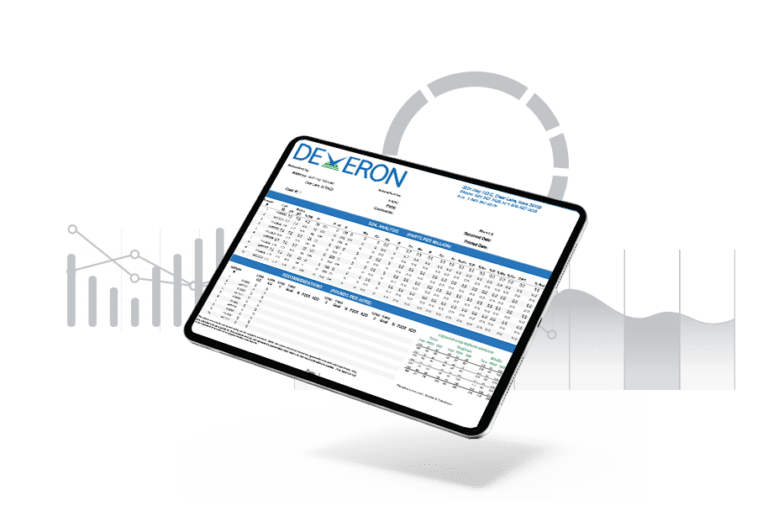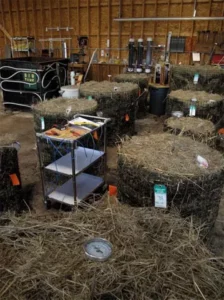✅ Save 2-3 week wait time of most labs
Solvita®: a Maturity Test that differs from other Compost Tests
Many composters worldwide employ Solvita® to monitor stage of compost and ensure quality during the course of the entire composting process and report end-product quality.

Quick Turnaround

Accurate Results

Improved recommendations

Solvita® Basic Compost Maturity Test
Overview: The Solvita compost maturity test is a unique procedure using two test probes to simultaneously measure CO2 and NH3, the two most prominent gases indicating activity and stability of compost.
This test is widely-recognized worldwide for validating compost maturity.
Application: This easy-to-use application requires a small sample placed in the incubation jars and the results are read after 4-hrs of exposure. The basic kit offers a Solvita color chart to determine the level of activity from which a Maturity Index is calculated using guidelines provided in the manual.
Woods End Laboratory Compost Analysis
STANDARD QUALITY: Basic integrated and practical compost quality test. This test is designed to reveal the overall balance of ingredients both physically and biologically, indicating both completeness of composting (maturity, volatile ammonia) and C:N ratio. Tests include: wet density, total solids, moisture, water holding capacity, pH, free carbonates, conductivity (EC), total organic matter, total nitrogen, C:N, ash content, Solvita® Maturity Index.
PREMIUM ANALYSIS: Comprehensive Quality Test. Includes all Basic Components plus total minerals (Ca, P, K, Na, Mg), soluble nitrogen (Ammonium and Nitrate), Trace Elements/Metals: Cu, Mn, Fe, Pb, Cr, Cd, Ni. Does not include EPA Metals Hg, As, Se, Mo.
PLANT RESPONSE: An excellent test to reveal diverse plant response. This integrated plant bioassay provides essential information for quality of growth of 3 different plant genera (Garden Cress, Wheat-Grass and Red Clover) from germination to emergence and early growth, and the presence of potentially harmful herbicidal residue and the calculated risk groups for plant growing. Also includes quantity of germinal weed seeds.
PREMIUM AND BEST USE CLASSIFICATION: Used for Compost Quality Certification. A robust protocol combining test data and a mathematical-array procedure to statistically validate a product for its highest and best-use potential. This test combines the above test categories of Premium Analysis and Plant Response used as input to a horticultural matrix-array which selects one of 5 Use-Groups as the one that scores the best, showing 2nd place and statistical score. A well-proven means to identify the probable best-use category of any growing-media product.
Compost Submission Form
Submit Your Compost Sample for Expert Analysis
Submit your sample today and let Woods End Laboratories or A&L Canada Laboratories provide you with expert analysis and insights. Our comprehensive compost submission form makes it easy to get started on the path to improved soil health and sustainable practices.

A&L Canada Laboratory Compost Analysis
Basic Monitoring Analysis Plus
Total Phosphorus, Total Potassium, Total Nitrogen, pH, Organic Matter, C:N ratio, Sodium, Moisture, Ash, Total Organic Carbon, Bulk Density
EnvironmentalTrace Elements
Arsenic, Cadmium, Chromium, Cobalt, Copper, Lead, Mercury, Molybdenum, Nickel, Selenium, Zinc
Compost Quality Parameters
Total Organic Matter, pH, Nitrogen, Phosphorus, Potassium, Magnesium, Calcium, Sulphur, Boron, Copper, Manganese, Iron, Zinc, Sodium, Aluminum, Soluble Salts, Moisture, SAR, C:N ratio, Organic Carbon, Ash.
Soil Suitability (S8C)
Available Organic Matter, pH, Lime Index, Phosphorus, Potassium, Magnesium, Zinc, Iron, Aluminum, NO3-N, Soluble Salts, Moisture, C:N ratio
Other Environmental Tests
C: N Ratio: / PCB’s: / Repirometry (CO2 Evolution or Dewar Self-heating test) : / Total Carbon: / Carbon: Nitrogen Ratio: / Moisture: / Bulk Density: / Germination Maturity Test (Water Cress and Radish): / Nitrate Nitrogen: / Organic Matter Content: / Total Inert Materials (% Glass, % Plastic, % Metal): / Particle Size 50mm(2 in), 25mm(1 in), 15mm(5/8 in), 9.5mm(3/8 in), 4mm(1/8 in)
S8
Organic Matter, pH, Phosphorus, Potassium, Calcium (using Mehlich III extraction)
S8A
S8 plus Zinc, Manganese, Iron, Copper, Boron, Sulphur
S8B
S8A plus Conductivity and Nitrate-N
S8C
Compost Analysis – pH, Lime Index, available Organic Matter, P, K, Mg, Ca, S, B, Cu, zn, Fe, Na, NO3-N, Sol Salts, Moisture, C:N Ratio
S9
pH, Phosphorus, Potassium, Magnesium, Calcium (saturated paste extraction)
S9A
S9 plus Zinc, Manganese, Iron, Copper, Boron, Sulphur
S9B
S9A plus Zinc, Manganese, Iron, Copper, Boron, Sulphur
Compost Videos
Compost FAQs
Compost analysis is the process of evaluating the nutrient content, maturity, and quality of composted organic materials. It is important because it helps determine the suitability of compost for use as a soil amendment, assess its nutrient contribution to plants, and ensure its compliance with regulatory standards.
Compost analysis involves collecting a representative sample of compost, preparing it for laboratory testing, and conducting various analyses using methods such as wet chemistry, spectrophotometry, titration, and microbial assays.
Results indicate the nutrient content (e.g., nitrogen, phosphorus, potassium) available for plant uptake, the stability and maturity of compost, its potential impact on soil pH and nutrient balance, as well as any contaminants or pathogens present. Results of compost analysis also indicate if the compost is fully composted and safe to apply.
Benefits include optimizing compost application rates based on nutrient content, improving soil fertility and structure, reducing reliance on synthetic fertilizers, enhancing plant growth and yield, and promoting sustainable agriculture practices.
Compost should be tested periodically, especially before significant applications, to monitor nutrient levels, assess compost quality and stability, and ensure consistency in nutrient supply to plants.
Yes, compost analysis can identify deficiencies or excesses in nutrients, assess compost maturity and decomposition progress, detect contaminants or pollutants, and guide adjustments in composting processes for optimal outcomes.
Yes, regulatory agencies may have guidelines or standards for compost quality, including limits for heavy metals, pathogens, and other contaminants. Compost analysis helps ensure compliance with these standards and promotes safe use.
Factors include the initial feedstock composition (e.g., manure, yard waste, food scraps), composting methods (e.g., aerobic vs. anaerobic, temperature, duration), turning frequency, moisture levels, and microbial activity.
Yes, compost analysis can be customized to focus on specific nutrients of interest, tailor nutrient recommendations for different crops or soil types, and provide insights for effective compost management and application strategies.
